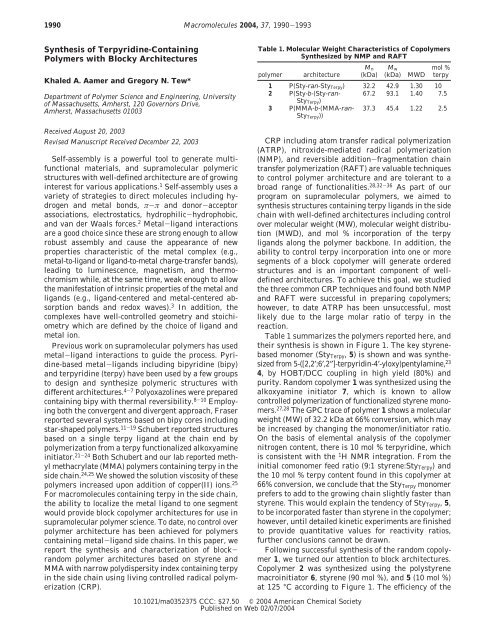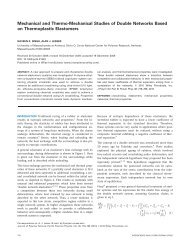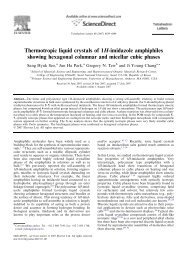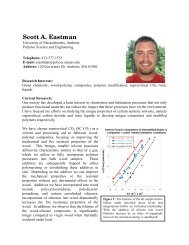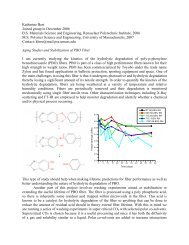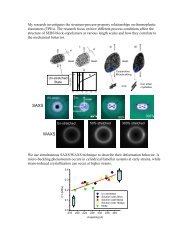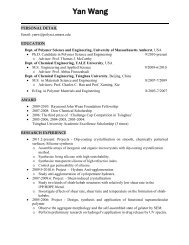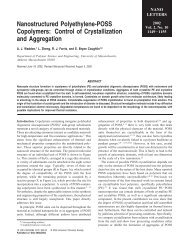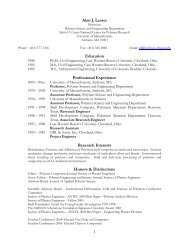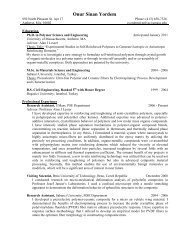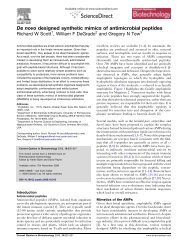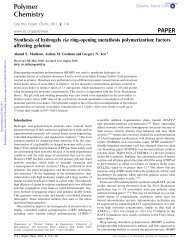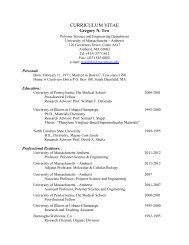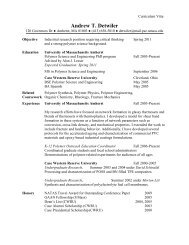Synthesis of Terpyridine-Containing Polymers with Blocky ...
Synthesis of Terpyridine-Containing Polymers with Blocky ...
Synthesis of Terpyridine-Containing Polymers with Blocky ...
You also want an ePaper? Increase the reach of your titles
YUMPU automatically turns print PDFs into web optimized ePapers that Google loves.
1990 Macromolecules 2004, 37, 1990-1993<br />
<strong>Synthesis</strong> <strong>of</strong> <strong>Terpyridine</strong>-<strong>Containing</strong><br />
<strong>Polymers</strong> <strong>with</strong> <strong>Blocky</strong> Architectures<br />
Khaled A. Aamer and Gregory N. Tew*<br />
Department <strong>of</strong> Polymer Science and Engineering, University<br />
<strong>of</strong> Massachusetts, Amherst, 120 Governors Drive,<br />
Amherst, Massachusetts 01003<br />
Received August 20, 2003<br />
Revised Manuscript Received December 22, 2003<br />
Self-assembly is a powerful tool to generate multifunctional<br />
materials, and supramolecular polymeric<br />
structures <strong>with</strong> well-defined architecture are <strong>of</strong> growing<br />
interest for various applications. 1 Self-assembly uses a<br />
variety <strong>of</strong> strategies to direct molecules including hydrogen<br />
and metal bonds, π-π and donor-acceptor<br />
associations, electrostatics, hydrophilic-hydrophobic,<br />
and van der Waals forces. 2 Metal-ligand interactions<br />
are a good choice since these are strong enough to allow<br />
robust assembly and cause the appearance <strong>of</strong> new<br />
properties characteristic <strong>of</strong> the metal complex (e.g.,<br />
metal-to-ligand or ligand-to-metal charge-transfer bands),<br />
leading to luminescence, magnetism, and thermochromism<br />
while, at the same time, weak enough to allow<br />
the manifestation <strong>of</strong> intrinsic properties <strong>of</strong> the metal and<br />
ligands (e.g., ligand-centered and metal-centered absorption<br />
bands and redox waves). 3 In addition, the<br />
complexes have well-controlled geometry and stoichiometry<br />
which are defined by the choice <strong>of</strong> ligand and<br />
metal ion.<br />
Previous work on supramolecular polymers has used<br />
metal-ligand interactions to guide the process. Pyridine-based<br />
metal-ligands including bipyridine (bipy)<br />
and terpyridine (terpy) have been used by a few groups<br />
to design and synthesize polymeric structures <strong>with</strong><br />
different architectures. 4-7 Polyoxazolines were prepared<br />
containing bipy <strong>with</strong> thermal reversibility. 8-10 Employing<br />
both the convergent and divergent approach, Fraser<br />
reported several systems based on bipy cores including<br />
star-shaped polymers. 11-19 Schubert reported structures<br />
based on a single terpy ligand at the chain end by<br />
polymerization from a terpy functionalized alkoxyamine<br />
initiator. 21-24 Both Schubert and our lab reported methyl<br />
methacrylate (MMA) polymers containing terpy in the<br />
side chain. 24,25 We showed the solution viscosity <strong>of</strong> these<br />
polymers increased upon addition <strong>of</strong> copper(II) ions. 25<br />
For macromolecules containing terpy in the side chain,<br />
the ability to localize the metal ligand to one segment<br />
would provide block copolymer architectures for use in<br />
supramolecular polymer science. To date, no control over<br />
polymer architecture has been achieved for polymers<br />
containing metal-ligand side chains. In this paper, we<br />
report the synthesis and characterization <strong>of</strong> blockrandom<br />
polymer architectures based on styrene and<br />
MMA <strong>with</strong> narrow polydispersity index containing terpy<br />
in the side chain using living controlled radical polymerization<br />
(CRP).<br />
Table 1. Molecular Weight Characteristics <strong>of</strong> Copolymers<br />
Synthesized by NMP and RAFT<br />
Mn Mw<br />
mol %<br />
polymer architecture (kDa) (kDa) MWD terpy<br />
1 P(Sty-ran-StyTerpy) 32.2 42.9 1.30 10<br />
2 P(Sty-b-(Sty-ran- 67.2 93.1 1.40 7.5<br />
StyTerpy)<br />
3 P(MMA-b-(MMA-ran-<br />
StyTerpy))<br />
37.3 45.4 1.22 2.5<br />
CRP including atom transfer radical polymerization<br />
(ATRP), nitroxide-mediated radical polymerization<br />
(NMP), and reversible addition-fragmentation chain<br />
transfer polymerization (RAFT) are valuable techniques<br />
to control polymer architecture and are tolerant to a<br />
broad range <strong>of</strong> functionalities. 28,32-36 As part <strong>of</strong> our<br />
program on supramolecular polymers, we aimed to<br />
synthesis structures containing terpy ligands in the side<br />
chain <strong>with</strong> well-defined architectures including control<br />
over molecular weight (MW), molecular weight distribution<br />
(MWD), and mol % incorporation <strong>of</strong> the terpy<br />
ligands along the polymer backbone. In addition, the<br />
ability to control terpy incorporation into one or more<br />
segments <strong>of</strong> a block copolymer will generate ordered<br />
structures and is an important component <strong>of</strong> welldefined<br />
architectures. To achieve this goal, we studied<br />
the three common CRP techniques and found both NMP<br />
and RAFT were successful in preparing copolymers;<br />
however, to date ATRP has been unsuccessful, most<br />
likely due to the large molar ratio <strong>of</strong> terpy in the<br />
reaction.<br />
Table 1 summarizes the polymers reported here, and<br />
their synthesis is shown in Figure 1. The key styrenebased<br />
monomer (StyTerpy, 5) is shown and was synthesized<br />
from 5-([2,2′;6′,2′′]-terpyridin-4′-yloxy)pentylamine, 23<br />
4, by HOBT/DCC coupling in high yield (80%) and<br />
purity. Random copolymer 1 was synthesized using the<br />
alkoxyamine initiator 7, which is known to allow<br />
controlled polymerization <strong>of</strong> functionalized styrene monomers.<br />
27,28 The GPC trace <strong>of</strong> polymer 1 shows a molecular<br />
weight (MW) <strong>of</strong> 32.2 kDa at 66% conversion, which may<br />
be increased by changing the monomer/initiator ratio.<br />
On the basis <strong>of</strong> elemental analysis <strong>of</strong> the copolymer<br />
nitrogen content, there is 10 mol % terpyridine, which<br />
is consistent <strong>with</strong> the 1 H NMR integration. From the<br />
initial comonomer feed ratio (9:1 styrene:StyTerpy) and<br />
the 10 mol % terpy content found in this copolymer at<br />
66% conversion, we conclude that the StyTerpy monomer<br />
prefers to add to the growing chain slightly faster than<br />
styrene. This would explain the tendency <strong>of</strong> StyTerpy, 5,<br />
to be incorporated faster than styrene in the copolymer;<br />
however, until detailed kinetic experiments are finished<br />
to provide quantitative values for reactivity ratios,<br />
further conclusions cannot be drawn.<br />
Following successful synthesis <strong>of</strong> the random copolymer<br />
1, we turned our attention to block architectures.<br />
Copolymer 2 was synthesized using the polystyrene<br />
macroinitiator 6, styrene (90 mol %), and 5 (10 mol %)<br />
at 125 °C according to Figure 1. The efficiency <strong>of</strong> the<br />
10.1021/ma0352375 CCC: $27.50 © 2004 American Chemical Society<br />
Published on Web 02/07/2004
Macromolecules, Vol. 37, No. 5, 2004 Notes 1991<br />
Figure 1. Scheme for the synthesis <strong>of</strong> monomer 5, NMP, and RAFT copolymerization <strong>of</strong> 1, 2, and 3.<br />
polystyrene macroinitiator to reinitiate monomer is<br />
evidenced from the overlaid GPC chromatograms in<br />
Figure 2, which shows both the macroinitiator and<br />
copolymer. 27,28 The presence <strong>of</strong> the terpy causes broadening<br />
<strong>of</strong> the peak, which is consistent <strong>with</strong> previous<br />
reports on pyridine-containing polymers. 37 The high mol<br />
% incorporation <strong>of</strong> terpy obtained at 56% conversion is<br />
consistent <strong>with</strong> observations from the synthesis <strong>of</strong> 1 in<br />
which 5 appears to add to the growing chain in preference<br />
to styrene. These results show NMP allows blocky<br />
architectures, based on styrene, to be prepared in which<br />
the terpy unit is confined to one segment.<br />
The synthesis <strong>of</strong> block-random MMA structures was<br />
undertaken to complement our initial report on random<br />
terpy-containing MMA polymers. 25 However, NMP is<br />
not the best choice for MMA synthesis, and so we<br />
explored RAFT polymerization. 30 Polymer 3 was successfully<br />
prepared using MMA macro-chain-transfer<br />
agent 9, AIBN, MMA (90 mol %), and 5 (10 mol %) in<br />
benzene at 60 °C as shown in Figure 1. Figure 3 shows<br />
the overlaid GPC traces for 9 and copolymer 3. The total<br />
mol % incorporation <strong>of</strong> terpy is only 2.5 mol % based on<br />
elemental analysis <strong>of</strong> the nitrogen content and 1 H NMR<br />
at 95% conversion. This indicates monomer 5 has a<br />
lower tendency to be incorporated than MMA in the<br />
copolymer under the RAFT conditions. The GPC trace<br />
shows little broadening in the peak, most likely due to<br />
the decreased mol % incorporation <strong>of</strong> terpy compared<br />
to 2.<br />
UV-vis spectroscopy in CHCl3 confirms incorporation<br />
<strong>of</strong> terpy in all three polymer samples. Figure 4 shows<br />
the UV-vis spectrum <strong>of</strong> StyTerpy monomer, 5, which has
1992 Notes Macromolecules, Vol. 37, No. 5, 2004<br />
Figure 2. Overlaid GPC trace <strong>of</strong> polystyrene macroinitiator end-capped <strong>with</strong> the alkoxyamine, 6, and poly(styrene-b-(styreneran-StyTerpy)),<br />
2, synthesized via NMP in THF mobile phase.<br />
Figure 3. Overlaid GPC trace <strong>of</strong> R,ω-(thiobenzoylthio)poly(methyl methacrylate) macro-chain-transfer agent, 9, and poly(MMAb-(MMA-ran-StyTerpy)),<br />
3, synthesized via RAFT in THF as mobile phase.<br />
two distinct transitions at 277 and 244 nm. The spectra<br />
<strong>of</strong> 1 and 2 were normalized to 5, showing similar peak<br />
intensity expected for these polymers since they contain<br />
both styrene and terpy functions. In contrast, the<br />
spectrum <strong>of</strong> 3 is not normalized since there is much less<br />
absorption at 244 nm due to the absence <strong>of</strong> styrene in<br />
the backbone and the low mol % terpy incorporation;<br />
however, the spectrum confirms terpy incorporation.<br />
In conclusion, we report the first CRP <strong>of</strong> terpy<br />
monomers, based on vinylbenzamides, to synthesize<br />
styrene and MMA copolymers <strong>with</strong> terpy in the side<br />
chain and control over MW, MWD, composition, and<br />
architecture. CRP (NMP and RAFT) allows the synthesis<br />
<strong>of</strong> block copolymers <strong>with</strong> terpy functions confined to<br />
one block which represents a new architecture for<br />
supramolecular polymers containing pyridine ligands.
Macromolecules, Vol. 37, No. 5, 2004 Notes 1993<br />
Figure 4. UV-vis spectra <strong>of</strong> copolymers 1,2, and 3 and monomer 5 in chlor<strong>of</strong>orm containing 1% ethanol.<br />
The successful syntheses <strong>of</strong> these block copolymers will<br />
facilitate the study <strong>of</strong> novel supramolecular polymers<br />
<strong>with</strong> interesting assembly properties.<br />
Acknowledgment. This work was supported by the<br />
MRSEC program <strong>of</strong> the National Science Foundation<br />
under Award (DMR 9400488). G.N.T. thanks ONR for<br />
a Young Investigators Award and 3M Corporation for<br />
a Non-tenured Faculty Award. The authors thank Dr.<br />
Craig Hawker for fruitful discussion and providing the<br />
alkoxyamine initiator.<br />
Supporting Information Available: Synthetic procedures<br />
and materials characterization data. This material is<br />
available free <strong>of</strong> charge via the Internet at http://pubs.acs.org.<br />
References and Notes<br />
(1) Ikkala, O.; Brinke, G. T. Science 2002, 295, 2407-2409.<br />
(2) Lehn, J.-M. Supramolecular ChemistrysConcepts and Prospectives;<br />
VCH: Weinheim, 1995.<br />
(3) Balzani, V.; Juris, A.; Venturi, M.; Campagna, S.; Serroni,<br />
S. Chem. Rev. 1996, 96, 759-833.<br />
(4) Lohmeijer, B. G. G.; Schubert, U. S. J. Polym. Sci., Polym<br />
Chem. 2003, 41, 1413-1427.<br />
(5) Potts, K. T.; Usifer, D. A. Macromolecules 1988, 21, 1985-<br />
1991.<br />
(6) Hanabusa, K.; Nakano, K.; Koyama, T.; Shirai, H.; Hojo,<br />
N.; Kurose, A. Makromol. Chem. 1990, 191, 391-396.<br />
(7) Hanabusa, K.; Nakamura, A.; Koyama, T.; Shirai, H.<br />
Makromol. Chem. 1992, 193, 1309-1319.<br />
(8) Chujo, Y.; Sada, K.; Saegusa, T. Macromolecules 1993, 26,<br />
6320-6323.<br />
(9) Chujo, Y.; Sada, K.; Saegusa, T. Macromolecules 1993, 26,<br />
6315-6319.<br />
(10) Chujo, Y.; Sada, K.; Saegusa, T. Polym. J. 1993, 23, 599-<br />
608.<br />
(11) Johnson, R. M.; Ng, C.; Samson, C. C. M.; Fraser, C. L.<br />
Macromolecules 2000, 33, 8618-8628.<br />
(12) Lamba, J. J. S.; Fraser, C. L. J. Am. Chem. Soc. 1997, 119,<br />
1801-1802.<br />
(13) McAlvin, J. E.; Fraser, C. L. Macromolecules 1999, 32,<br />
1341-1347.<br />
(14) McAlvin, J. E.; Fraser, C. L. Macromolecules 1999, 32,<br />
6925-6932.<br />
(15) McAlvin, J. E.; Scott, S. B.; Fraser, C. L. Macromolecules<br />
2000, 33, 6953-6964.<br />
(16) Park, C. M.; McAlvin, J. E.; Fraser, C. L.; Thomas, E. L.<br />
Chem. Mater. 2002, 14, 1225-1230.<br />
(17) Smith, A. P.; Fraser, C. L. Macromolecules 2003, 36, 2654-<br />
2660.<br />
(18) Wu, X. F.; Collings, J. E.; McAlvin, J. E.; Cutts, R. W.;<br />
Fraser, C. L. Macromolecules 2001, 34, 2812-2821.<br />
(19) Wu, X. F.; Fraser, C. L. Macromolecules 2000, 33, 4053-<br />
4060.<br />
(20) Schubert, U. S.; Eschbaumer, C. Angew. Chem., Int. Ed.<br />
2002, 41, 2892-2926.<br />
(21) Gohy, J. F.; Lohmeijer, B. G. G.; Schubert, U. S. Macromol.<br />
Rapid Commun. 2002, 23, 555-560.<br />
(22) Schubert, U. S.; Eschbaumer, C.; Andres, P.; H<strong>of</strong>meier, H.;<br />
Weidl, C. H.; Herdtweck, E.; Dulkeith, E.; Morteani, A.;<br />
Hecker, N. E.; Feldmann, J. Synth. Met. 2001, 121, 1249-<br />
1252.<br />
(23) Schubert, U. S.; Eschbaumer, C.; Hien, O.; Andres, P. R.<br />
Tetrahedron Lett. 2001, 42, 4705-4707.<br />
(24) Schubert, U. S.; H<strong>of</strong>meier, H. Macromol. Rapid Commun.<br />
2002, 23, 561-566.<br />
(25) Calzia, K. J.; Tew, G. N. Macromolecules 2002, 35, 6090-<br />
6093.<br />
(26) Newkome, G. R.; He, E. J. Mater. Chem. 1997, 7, 1237-<br />
1244.<br />
(27) Benoit, D.; Chaplinski, V.; Braslau, R.; Hawker, C. J. J. Am.<br />
Chem. Soc. 1999, 121, 3904-3920.<br />
(28) Hawker, C. J.; Bosman, A. W.; Harth, E. Chem. Rev. 2001,<br />
101, 3661-3688.<br />
(29) Donovan, M. S.; Sanford, T. A.; Lowe, A. B.; Sumerlin, B.<br />
S.; Mitsukami, Y.; McCormick, C. L. Macromolecules 2002,<br />
35, 4570-4772.<br />
(30) Nakamoto, K. J. Phys. Chem. 1960, 64, 1420-1425.<br />
(31) Lee, J.; Hogen-Esch, T. E. Macromolecules 2001, 34, 2805-<br />
2811.<br />
(32) Evans, R. A.; Rizzardo, E. Macromolecules 1996, 29, 6983-<br />
6989.<br />
(33) Ganachaud, F.; Monteiro, M. J.; Gilbert, R. G.; Dourges, M.<br />
A.; Thang, S. H.; Rizzardo, E. Macromolecules 2000, 33,<br />
6738-6745.<br />
(34) Moad, G.; Mayadunne, R. T. A.; Rizzardo, E.; Skidmore, M.;<br />
Thang, S. H. Macromol. Symp. 2003, 192, 1-12.<br />
(35) Donovan, M. S.; Sanford, T. A.; Lowe, A. B.; Sumerlin, B.<br />
S.; Mitsukami, Y.; McCormick, C. L. Macromolecules 2002,<br />
35, 4570-4772.<br />
(36) Gotz, H.; Harth, E.; Schiller, S. M.; Frank, C. W.; Knoll, W.;<br />
Hawker, C. J. J. Polym. Sci., Polym. Chem. 2002, 40, 3379-<br />
3391.<br />
(37) Peter, K.; Thelakkat, M. Macromolecules 2003, 36, 1779-<br />
1785.<br />
MA0352375


